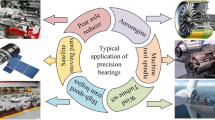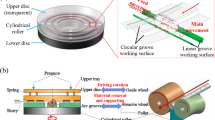Abstract
Consistency finishing is one of the technical bottlenecks in performance-oriented manufacturing for bearing rings, while non-destructive and all-around processing is its core demand. To accomplish this objective, a novel rotary barrel finishing approach, which was floating clamp, friction drive, and horizontal limit, was proposed. First, the effect of the vessel rotation speed on bearing ring’s motion and media kinetic energy’s distribution was investigated by the ADAMS-EDEM co-simulation. The bearing ring can realize continuous rotation and be effectively limited within some intervals under different vessel rotation speeds. The media kinetic energy is uniformly distributed in the radical direction. And it can reach the maximum when the rotation speed of the vessel is 40 rpm, which is considered to obtain the best finishing effect. Subsequently, the surface roughness of the workpiece was investigated by optimal finishing experiment. It shows that the surface roughness of bearing ring surfaces can be improved. Moreover, the coefficient of variation of Ra on the inner surface, end face1, and end face2 were reduced to 9.25% to 5.33%, 7.35%, and 5.73% respectively. The research results indicate that the bearing ring surfaces can be finished simultaneously and clamed non-destructive by this finishing approach. This process provides reference and basis for ring-shaped parts finishing.

















Similar content being viewed by others
Data availability
The datasets supporting the results of this article are included within the article.
References
Hashimoto Y, Nakayama Y, Furumoto T, Hosokawa A (2022) Improving finishing efficiency using a cover plate in gyro finishing. Precis Eng 74:140–146. https://doi.org/10.1016/j.precisioneng.2021.11.004
Lee J-Y, Nagalingam AP, Yeo SH (2021) A review on the state-of-the-art of surface finishing processes and related ISO/ASTM standards for metal additive manufactured components. Virtual Phys Prototyp 16:68–96. https://doi.org/10.1080/17452759.2020.1830346
Hashimoto F, Yamaguchi H, Krajnik P et al (2016) Abrasive fine-finishing technology. CIRP Ann 65:597–620. https://doi.org/10.1016/j.cirp.2016.06.003
Kakinuma Y, Igarashi K, Katsura S, Aoyama T (2013) Development of 5-axis polishing machine capable of simultaneous trajectory, posture, and force control. CIRP Ann 62:379–382. https://doi.org/10.1016/j.cirp.2013.03.135
Qu S, Yao P, Gong Y et al (2022) Environmentally friendly grinding of C/SiCs using carbon nanofluid minimum quantity lubrication technology. J Clean Prod 366:132898. https://doi.org/10.1016/j.jclepro.2022.132898
Zhang Y, Li C, Jia D et al (2015) Experimental evaluation of the lubrication performance of MoS2/CNT nanofluid for minimal quantity lubrication in Ni-based alloy grinding. Int J Mach Tools Manuf 99:19–33. https://doi.org/10.1016/j.ijmachtools.2015.09.003
Cui X, Li C, Ding W, et al (2021) Minimum quantity lubrication machining of aeronautical materials using carbon group nanolubricant: from mechanisms to application. Chinese Journal of Aeronautics S1000936121002880 https://doi.org/10.1016/j.cja.2021.08.011
Wu MY, Gao H (2016) Experimental study on large size bearing ring raceways’ precision polishing with abrasive flowing machine (AFM) method. Int J Adv Manuf Technol 83:1927–1935. https://doi.org/10.1007/s00170-015-7706-x
Deng Q, Zheng T, Wang X et al (2021) Analysis of electric field electrode distribution on dielectrophoresis abrasive flow for polishing internal surface of ceramic workpiece. Int J Adv Manuf Technol 113:2355–2367. https://doi.org/10.1007/s00170-021-06726-y
Li M, Huang Z, Dong T et al (2018) Surface integrity of bearing steel element with a new high-efficiency shear thickening polishing technique. Procedia CIRP 71:313–316. https://doi.org/10.1016/j.procir.2018.05.030
Yang S, Li W (2018) Surface finishing theory and new technology. Springer, Berlin and Heidelberg
Gillespie LK (2007) Mass Finishing Handbook, 1st edn. Industrial Press, New York
Alcaraz JY, Zhang J, Nagalingam AP et al (2022) Numerical modeling of residual stresses during vibratory peening of a 3-stage Blisk – a multi-scale discrete element and finite element approach. J Mater Process Technol 299:117–383. https://doi.org/10.1016/j.jmatprotec.2021.117383
Mediratta R, Ahluwalia K, Yeo SH (2016) State-of-the-art on vibratory finishing in the aviation industry: an industrial and academic perspective. Int J Adv Manuf Technol 85:415–429. https://doi.org/10.1007/s00170-015-7942-0
Zhu HP, Zhou ZY, Yang RY, Yu AB (2008) Discrete particle simulation of particulate systems: a review of major applications and findings. Chem Eng Sci 63:5728–5770. https://doi.org/10.1016/j.ces.2008.08.006
Hao Y, Yang S, Li X et al (2021) Analysis of contact force characteristics of vibratory finishing within pipe-cavity. Granular Matter 23:32. https://doi.org/10.1007/s10035-021-01089-3
Wang X, Wang Y, Yang S, Hao Y (2021) Analysis of velocity of granular media in cascade finishing by discrete element method with experimental validation. Granular Matter 23:83. https://doi.org/10.1007/s10035-021-01154-x
Na W, Tingting Z, Sheng-qiang Y et al (2020) Experiment and simulation analysis on the mechanism of the spindle barrel finishing. Int J Adv Manuf Technol 109:57–74. https://doi.org/10.1007/s00170-020-05609-y
Hashimoto Y, Ito T, Nakayama Y et al (2021) Fundamental investigation of gyro finishing experimental investigation of contact force between cylindrical workpiece and abrasive media under dry condition. Precis Eng 67:123–136. https://doi.org/10.1016/j.precisioneng.2020.09.009
Silveira JC, Lima RM, Brandao RJ et al (2022) A study of the design and arrangement of flights in a rotary drum. Powder Technol 395:195–206. https://doi.org/10.1016/j.powtec.2021.09.043
Ma H, Zhao Y (2017) Modelling of the flow of ellipsoidal particles in a horizontal rotating drum based on DEM simulation. Chem Eng Sci 172:636–651. https://doi.org/10.1016/j.ces.2017.07.017
Uhlmann E, Eulitz A, Dethlefs A (2015) Discrete element modelling of drag finishing. Procedia CIRP 31:369–374. https://doi.org/10.1016/j.procir.2015.03.021
Li W, Zhang L, Li X et al (2017) Theoretical and simulation analysis of abrasive particles in centrifugal barrel finishing: kinematics mechanism and distribution characteristics. Powder Technol 318:518–527. https://doi.org/10.1016/j.powtec.2017.06.033
Hashemnia K, Spelt JK (2014) Particle impact velocities in a vibrationally fluidized granular flow: measurements and discrete element predictions. Chem Eng Sci 109:123–135. https://doi.org/10.1016/j.ces.2014.01.027
Tsuji Y, Tanaka T, Ishida T (1992) Lagrangian numerical simulation of plug flow of cohesionless particles in a horizontal pipe. Powder Technol 71:239–250
Cundall PA, Strack ODL (1979) A discrete numerical model for granular assemblies. Géotechnique 29:47–65. https://doi.org/10.1680/geot.1979.29.1.47
da Silva ML, Spelt JK (2020) Comparison of DEM predictions and measured wall-media contact forces and work in a vibratory finisher. Powder Technol 366:434–447. https://doi.org/10.1016/j.powtec.2020.02.014
Danby M, Shrimpton J, Palmer M (2013) On the optimal numerical time integration for DEM using Hertzian force models. Comput Chem Eng 58:211–222. https://doi.org/10.1016/j.compchemeng.2013.06.018
Mellmann J (2001) The transverse motion of solids in rotating cylinders—forms of motion and transition behavior. Powder Technol 118:251–270. https://doi.org/10.1016/S0032-5910(00)00402-2
Khorasani M, Ghasemi AH, Farabi E et al (2022) A comprehensive investigation of abrasive barrel finishing on hardness and manufacturability of laser-based powder bed fusion hollow components. Int J Adv Manuf Technol 120:3471–3490. https://doi.org/10.1007/s00170-022-08903-z
Lommen S, Lodewijks G, Schott DL (2018) Cosimulation framework of discrete element method and multibody dynamics models. EC 35:1481–1499. https://doi.org/10.1108/EC-07-2017-0246
Zuo Z, Gong S, Xie G, Zhang J (2021) DEM simulation of binary mixing particles with different density in an intensive mixer. Powder Technol 383:454–470. https://doi.org/10.1016/j.powtec.2021.01.064
Funding
The work was co-supported by the National Natural Science Foundation of China (Grant No. 52075362, 51875389, and 51975399).
Author information
Authors and Affiliations
Contributions
Xuenan Li designed and performed the manuscript, analyzed the data, and drafted the manuscript. Shengqiang Yang conceived and supervised the study and edited the manuscript. Xiuhong Li and Yupeng Hao analyzed the data. Dongxiang Li performed the experiments. Wenhui Li analyzed the data. All authors read and approved the manuscript.
Corresponding author
Ethics declarations
Ethics approval
Not applicable.
Consent to participate
Not applicable.
Consent to publication
All authors have consent for publication.
Conflict of interest
The authors declare no competing interests.
Additional information
Publisher’s note
Springer Nature remains neutral with regard to jurisdictional claims in published maps and institutional affiliations.
Rights and permissions
Springer Nature or its licensor (e.g. a society or other partner) holds exclusive rights to this article under a publishing agreement with the author(s) or other rightsholder(s); author self-archiving of the accepted manuscript version of this article is solely governed by the terms of such publishing agreement and applicable law.
About this article
Cite this article
Li, X., Yang, S., Li, X. et al. A novel rotary barrel finishing approach for high-performance bearing ring surfaces finishing simultaneously via floating clamp. Int J Adv Manuf Technol 131, 1975–1988 (2024). https://doi.org/10.1007/s00170-022-10377-y
Received:
Accepted:
Published:
Issue Date:
DOI: https://doi.org/10.1007/s00170-022-10377-y




